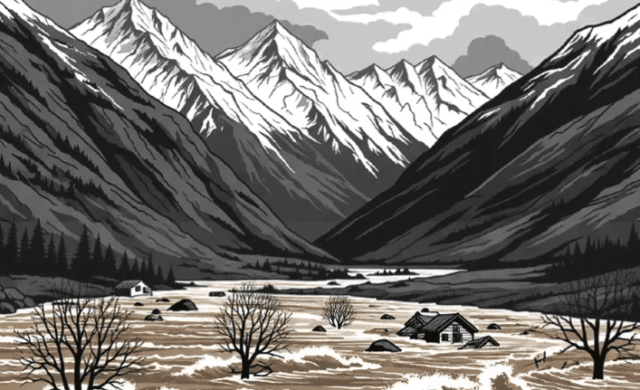Srinagar, Aug 6: As Uttarakhand’s Dharali village reels from a devastating cloudburst that left five persons dead under landslide debris and more than 50 missing, the tragedy has renewed concerns over the growing risk of similar disasters in Jammu and Kashmir – a region increasingly vulnerable to flash floods, landslides, and extreme weather events.
Experts say the disaster in Uttarakhand, which unfolded on Tuesday near Kheer Ganga following intense rainfall, is part of a larger pattern fueled by climate change, deforestation, and unregulated construction across the Himalayan belt, including Jammu and Kashmir (J&K) and Himachal Pradesh.
Search and rescue efforts continued into the late hours of Tuesday as emergency teams combed through the wreckage in Uttarakhand.
But in J&K, echoes of such tragedies are already being felt.
Late Tuesday night, around 11 pm, two people died and two others were injured when gusty winds, heavy rain, and lightning uprooted forest trees and fell on a nomadic tent in Kanzalpathri Dokh, Waltengo Nard, in the Kund valley of Devsar area of south Kashmir’s Kulgam district.
Muhammad Shafi Bokad and a woman identified as Rehana died on the spot.
Two others were injured and taken to a nearby medical facility for treatment.
On August 2, Sub-Divisional Magistrate (SDM) Rajinder Singh Rana and his minor son died in a landslide in Reasi district.
Rana’s wife and daughter were among five others injured in the incident.
That fatal landslide was only the latest in a series of climate-linked disasters to batter J&K in recent months.
On July 21, a landslide along the Mata Vaishno Devi shrine route in Reasi left a 70-year-old yatri dead and nine others injured.
On July 10, flash floods damaged the Jammu-Pathankot railway line, derailing a goods train in Kathua.
In early July, cloudbursts struck villages in Anantnag and Budgam, flooding homes and blocking roads.
In late June, three people were killed and dozens displaced as cloudbursts and flash floods hit Rajouri, Poonch, Doda, Udhampur, Ramban, and Kathua districts.
Much of the concern centres on the Banihal-Ramban stretch of the Srinagar-Jammu National Highway, a vital corridor that has witnessed repeated cave-ins and landslides.
In April, a 10-km section of the highway near Kela Morh collapsed, halting traffic and stranding hundreds of commuters.
Environmental scientists blame aggressive road-widening and tunnel construction along the highway, often carried out without sufficient geological assessments.
The practice of dumping excavation debris into the Chenab River or leaving it unsecured on slopes has further weakened the region’s terrain.
“The Himalayan terrain is naturally sensitive,” said Riyaz Ahmad Mir, a geologist at the National Institute of Hydrology in Jammu. “But human activity is amplifying the risk. We are building without regard to the ecology.”
The Chenab Valley – including Ramban, Doda, and Kishtwar – lies in seismic Zone IV and sits near active fault lines.
Yet, infrastructure projects often proceed without the involvement of geologists or environmental planners.
The 2022 collapse of an under-construction tunnel in Ramban, which left 10 workers dead, remains a stark reminder of these dangers.
While the National Highways Authority of India (NHAI) has since pivoted toward safer tunnel and viaduct designs at sites like Panthiyal and Digdol, critics say the reforms came too late.
Climate change is another compounding factor.
According to the Meteorological Department in J&K, rising temperatures are making rainfall more intense and erratic, ideal conditions for cloudbursts.
A 1 degree Celsius increase in temperature allows the atmosphere to hold 7 percent more moisture, boosting the chances of sudden, localised deluges.
Deforestation is accelerating the decline.
J&K lost more than 212 sq km of tree cover between 2001 and 2023, including 112 hectares in the past year alone.
Tree roots help stabilise slopes and absorb rainfall, and their removal leaves hillsides exposed to erosion and collapse.
“Unless geologists and ecologists are involved in every stage of development, these disasters will continue,” said Shahid Shafi, an environmentalist. “We cannot afford to keep ignoring nature’s warning signs.”
As Uttarakhand continues to search for its missing and mourn its dead, residents across J&K brace for what might come next.
In the hilly districts of J&K, people now live in quiet fear, watching the skies, listening for the next landslide, and hoping they won’t be next.








